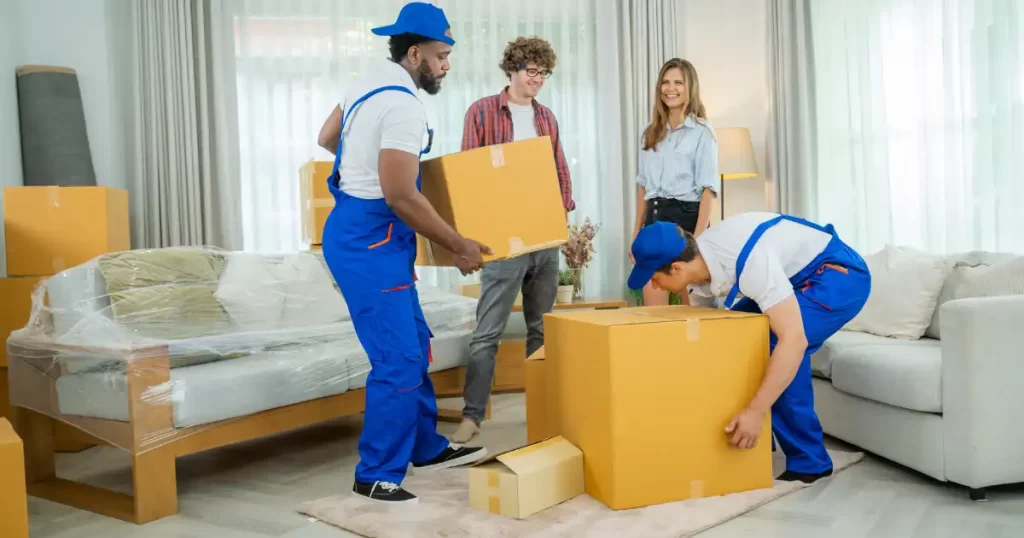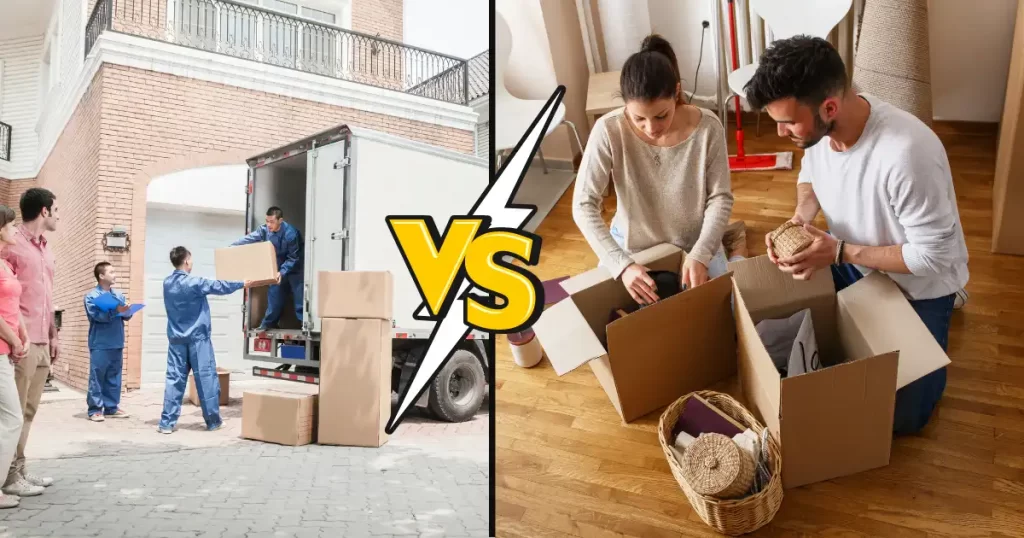
Efficiently packing for a house shift is not just about stuffing belongings into boxes; it’s a strategic process that can make your transition smoother and less stressful. Whether you’re moving across town or the country, proper packing techniques can save you time, money, and headaches.
Today, we will learn how to pack for shifting houses and the best packing tips for moving. Whether you’re a seasoned pro or a first-time mover, this blog is your road map to packing efficiently.
So, let’s get started!
Best ways to pack for moving house

- Declutter and Downsize Wisely
Before you dive into the packing process, it’s crucial to declutter and downsize your belongings wisely. Start by assessing each item in your home, considering its utility and sentimental value.
Ask yourself– Do I use this regularly? Is it really important for me? If not, it may be time to part ways. Consider donating or selling items that no longer serve a purpose in your life, freeing up space and reducing the load for your move.
Remember, the less you have to pack, the easier and more cost-effective your move will be. Take the time to declutter thoughtfully, ensuring that the items you keep are worth bringing to your new home.
- Planning and Prioritization
Once you have decluttered and downsized your belongings, it’s time to create a plan and prioritize your packing efforts.
Start by establishing a timeline for your move setting deadlines for when each room or area of your home should be packed up. This will help you stay organized and focused throughout the packing process.
Consider prioritizing rooms based on their importance and frequency of use, starting with those least essential or used less frequently, such as storage spaces or guest rooms, and work towards more essential areas like the kitchen and bedrooms.
By breaking the packing process down into smaller, manageable tasks, you can avoid feeling overwhelmed and ensure everything gets packed up on time.
Remember also to consider any special items or belongings that may require extra care or attention during the packing process and plan accordingly.
- Labeling and Organizing Boxes
Effective labeling and organization of boxes are essential steps in ensuring a smooth and efficient move. As you pack, clearly label each box with its contents and the room it belongs to in your new home. This simple step can save you time and frustration when unpacking. Consider using color-coded labels or markers to distinguish between boxes belonging to different rooms easily.
When organizing boxes, prioritize placing heavier items on the bottom and lighter items on top to prevent crushing or damage during transit. Stack boxes neatly and securely to maximize space in your moving vehicle and minimize the risk of shifting or toppling over.
- Packing Methods and Materials
Choosing the right packing methods and materials is essential for keeping your belongings safe and secure during the move.
Start by selecting sturdy, high-quality moving boxes in various sizes to accommodate different items. Reinforce the bottoms of boxes with packing tape to prevent them from collapsing under the weight of their contents.
For clothing and linens, consider using vacuum-sealed bags to maximize space and protect them from dust and moisture. Alternatively, large plastic bins with lids can protect delicate fabrics.
As you pack, be mindful of the weight of each box, aiming to distribute weight evenly to prevent strain and injury when lifting and carrying. Avoid overpacking boxes, as this can increase the risk of damage to both the contents and the box itself.
- Packing for Long-Distance Moves
Moving to a new home across a long distance presents unique challenges that require careful planning and preparation.
When packing for a long-distance move, prioritizing items essential for your immediate needs, such as clothing, toiletries, and important documents, is important. Pack these items in a separate “essentials” box that you can keep with you during the move rather than packing them in the moving truck.
Also, consider the timing of your move and any potential weather or road conditions that may impact your journey. Plan accordingly and allow extra time in case of delays, particularly if traveling during peak moving season.
- Protecting Fragile Items
Safeguarding fragile items during a move is essential to prevent breakage and ensure they arrive at your new home in one piece. Whether it’s delicate glassware, cherished ceramics, or valuable electronics, taking extra precautions when packing fragile items can make all the difference.
Begin by wrapping each fragile item individually in layers of protective materials, such as bubble wrap or packing paper, to cushion them against transit shock.
When packing fragile items, fill any space in the box with packing peanuts, crumpled paper, or foam padding to prevent shifting during transit. Pack heavier items at the bottom of the box and lighter items on top to distribute weight evenly and reduce the risk of breakage.
Label boxes containing fragile items clearly with the word “Fragile” and mark them with arrows(→) indicating which way is up to ensure they are handled with care during loading and unloading.
Hiring Movers vs. DIY Strategies

The cost of hiring professional movers might make you think if you do the heavy moving by yourself. Well, there are many pros and cons of hiring a professional movers. Let’s have a look–
Hiring professional movers
Pros
- Expertise: Experienced movers know how to pack efficiently, handle heavy furniture, and navigate tight spaces, saving you time and stress.
- Efficiency: They can complete the move quickly, minimizing disruption to your daily routine.
- Convenience: Professional movers handle all move aspects, including packing, loading, transportation, and unloading, saving you time and effort.
- Labor & Equipment: They have the manpower and specialized equipment to handle large furniture and heavy items, saving you physical strain.
- Insurance: Many companies offer moving insurance, providing financial protection in case of accidental damage.
Cons
- Cost: Hiring movers can be more expensive than DIY strategies, particularly for long-distance moves or larger households.
- Control: You might have less control over the packing and handling of your belongings.
- Availability: Popular moving dates can fill up quickly, requiring early booking and potentially higher prices.
DIY Strategies
Pros
- Cost-Effective: DIY moving strategies can be more budget-friendly, as you can save on labor costs by packing and transporting your belongings.
- Flexibility: With a DIY approach, you have greater flexibility and control over the moving process, allowing you to set your own timeline and priorities.
- Sense of Accomplishment: Completing a DIY move can be a rewarding experience, fostering a sense of accomplishment and pride.
Cons
- Time-Consuming: DIY moves require careful planning and organization and can be more time-consuming than hiring professional movers, especially for larger homes or long-distance moves.
- Physical Demands: Moving heavy furniture and boxes can be physically demanding and pose a risk of injury if not done properly.
- Lack of Expertise: Without the experience and expertise of professional movers, there is a higher risk of damage to your belongings or injury to yourself during the moving process.
- Limited Resources: DIY movers may lack access to specialized equipment or vehicles for transporting items, such as large furniture or vehicles.
Tips for Packing with Pets or Children

Packing for a house move can be challenging enough, but adding pets or children into the mix can become even more complicated.
Fortunately, with some careful planning and consideration, you can make the packing process easier for everyone involved.
- Create a safe environment
Set aside a quiet, out-of-the-way area where your pets or children can relax away from the chaos of packing. This will provide them with a sense of security and help prevent them from getting underfoot while you work.
- Pack Essentials Last
Pack your pets’ and children’s essentials, such as food, water, medication, and favorite toys, last so they are easily accessible throughout the moving process. Consider packing these items in a separate “essentials” box that you can keep during the move.
- Involve Them
Get your pets and children involved in the packing process where appropriate. Let them help pack their own belongings, such as toys or clothing, to give them a sense of ownership and involvement in the move.
- Unpacking
Let them explore their new space gradually. Introduce them to their designated room first, then allow them to explore the rest of the house at their own pace.
- Update Identification
Ensure your pets wear updated identification tags with your new address and contact information in case they get lost during the move.
Unpacking and Settling In Effectively

Once you’ve arrived at your new home, the unpacking process begins. Here are some tips to help you unpack and settle in effectively–
- Start with essentials
Begin by unpacking the essentials, such as bedding, toiletries, and kitchen essentials. This will help you feel more comfortable and settled in your new space immediately.
- Unpack room by room
Focus on unpacking one room at a time to avoid feeling overwhelmed. Start with the most important rooms, such as the kitchen and bedrooms, before moving on to less essential areas.
- Organize as you go.
As you unpack, take the time to organize your belongings and find a place for everything. This will help you maintain a sense of order and prevent clutter from building up.
- Take break
Moving can be physically and emotionally exhausting, so take breaks as needed. Pace yourself and listen to your body to avoid burnout.
Conclusion
Moving house can be daunting, but with careful planning, organization, and the right support, it can also be an exciting opportunity for a fresh start. So, the next time you ask yourself, “How to pack for a shifting house?” remember the tips and strategies in this guide.
Whether you hire our professional Man And Van Service or take a DIY approach, Easy Way Removals is committed to making your moving experience seamless and stress-free.
Get in touch to have a free quote!
FAQ
- How long before moving house should you start packing?
It’s best to start packing for your move at least a few weeks in advance, ideally four to six weeks before your moving date. This allows you to pack gradually and avoid last-minute stress.
- What is the best thing to pack first when moving?
Start by packing items that you use infrequently, such as off-season clothing, decorative items, and books. This helps you make progress without disrupting your daily routine.
- Can I pack to move in one day?
While possible, packing in one day isn’t recommended as it may lead to mistakes or forgotten items. Spreading the process over several days or weeks is advised.

 and europe
and europe 
